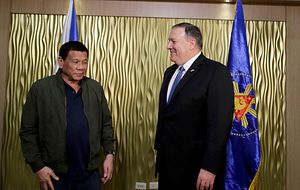In March, U.S. Secretary of State Mike Pompeo visited Manila, the capital of the Philippines. Publicly, and in no uncertain terms, he declared that the United States would honor its commitments under the Mutual Defense Treaty (MDT) should any Philippine vessel or aircraft be attacked anywhere in the South China Sea. Pompeo’s comments came amid uncertainties with respect to the alliance under Philippine President Rodrigo Duterte, including talk of a potential review of the alliance.
Though international focus was on the U.S. commitment itself and its significance, Philippine responses to Pompeo’s comments were more mixed due to a range of factors and in spite of Washington’s best efforts to boost collaboration with Manila. But beyond this, the hope is that Pompeo’s commitment will jumpstart a broader effort by the two allies to reinvigorate the U.S.-Philippine alliance in the coming years.
The State of the U.S.-Philippine Alliance
While there is often a focus on the troubles of the U.S.-Philippine alliance under Duterte, some of the more prominent issues in the alliance date back decades. Among these issues were repeated – and unsuccessful – Philippine attempts to extract a U.S. commitment to protect its South China Sea claims. Since 1979, through a letter of the Secretary of State Cyrus Vance, and reiterated in 1999 by U.S. Ambassador Thomas Hubbard, the United States quietly stated only that it considered MDT obligations to apply to all Philippine public ships and aircraft “in the Pacific,” which included the South China Sea, and that these did not have to be in the “metropolitan area” of the Philippines mentioned in the treaty’s Article V as well.
Some of these concerns have only deepened in recent years amid the rising threat of China to Philippine interests in the South China Sea. In particular, China’s taking of Scarborough Shoal in 2012 despite U.S. intercession during the presidency of Barack Obama loomed large in the mind of the security sector as an example of abandonment, irrespective of Washington’s own calculations at the time.
The Duterte administration has only intensified these doubts about the alliance. Since 2016, the Duterte administration has accommodated and at times echoed China’s positions on the South China Sea matter while touting an “independent foreign policy” whose principal feature appeared to be dissociation from the United States. This has been accompanied by calls from Philippine officials, including Defense Secretary Delfin Lorenzana, to review the alliance itself. This has also come in spite of ample demonstrations of U.S. support, including support for the Philippine military to end a siege by Islamic State-linked militants in Marawi, and assistance with respect to modernization, capacity-building, intelligence, and maritime domain awareness.

































